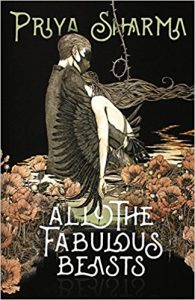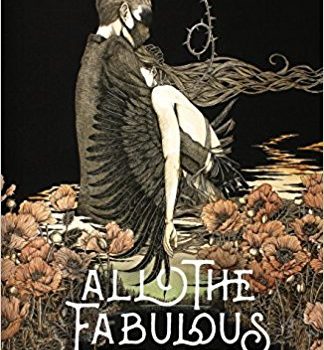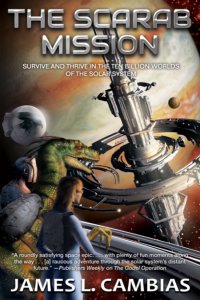John Langan Reviews All the Fabulous Beasts by Priya Sharma and At the Mercy of Beasts by Ed Kurtz
 All the Fabulous Beasts, Priya Sharma (Undertow 9781988964027, $17.99, 288pp, tp) May 2018.
All the Fabulous Beasts, Priya Sharma (Undertow 9781988964027, $17.99, 288pp, tp) May 2018.
“The Crow Palace”, the opening story in Priya Sharma’s luminous debut collection, All the Fabulous Beasts, begins with its protagonist revisiting a childhood memory. When she was young, Julie tells us, living with her parents and twin in a large house in the English countryside, her father built a bird table, an arrangement of large shelves on which Julie and Pippa, her sister, could put out various items to draw the local birds. Of the species that flew down to inspect their offerings, Julie remembers, the crows were the ones who dominated the construction, their black eyes, she tells us, filled with schemes. When Julie, now an adult, returns home from London after her father’s sudden death, she is greeted at the door to her old house by a crow, which is shooed away by the family friend overseeing her father’s funeral. The bird’s appearance is the first of an increasing number of visits by an increasing number of crows, whose black plumage seems to echo the mourning dress of the neighbors who come to the house offering their sympathies. The birds who live around the house act with a degree of unity so remarkable as to be uncanny, a flock of ravens descending on a cat that has caught a magpie and reducing the animal to blood and fur. As there is a mystery about the local bird population, so does Julie confront another, personal riddle: a locked box in one of her father’s wardrobes. When the magpies leave the key to the box on the bird table, the two levels of enigma converge. What Julie finds inside the box are select effects of her mother, dead of apparent suicide when Julie and Pippa were young children. Included with a bottle of her mother’s favorite perfume, some of her jewelry, and photographs of her and her husband are a pair of eggs wrapped in a handkerchief. Surprisingly heavy, the eggs are warm, and Julie cannot resist cracking them open. Their contents change her understanding of herself, her sister, her parents – of everything. The story concludes on a note of recognition between Julie and Pippa that poignantly acknowledges the distance and the continuing bond between them.
The narrative structure of “The Crow Palace”, in which a protagonist who feels in some way separate or alienated from the general course of human activity gradually realizes a profound connection to a species of animal, is further explored in a triptych of stories that close out the collection. In “The Nature of Bees”, Vivien Avery is taken into a kind of human beehive to be its queen, only to learn the horror of such a fate. In “A Son of the Sea”, Paul Cadigan learns that his inability ever to consummate a relationship with a woman, no matter how attracted to her he is, has its explanation in the depths of the sea. And in “Fabulous Beasts”, the powerhouse story that concludes the collection, first-person narrator Lola relates the story of her and her younger cousin Tallula’s upbringing in a housing estate outside Liverpool, their mothers living under the shadow of their brother, Kenny, imprisoned for beating a man to death during the commission of a robbery years before. Her paternity unknown by everyone except her mother, Lola is distinguished by her aptitude for and enjoyment of schoolwork, as well as her interest in snakes, a fascination that deeply horrifies her mother. Fiercely protective of her younger cousin, Lola bites the hand of a girl about to strike Tallula. When the bite causes the girl’s arm to swell and necessitates her treatment for blood poisoning, Lola’s mother calls her a monster and threatens to kill her if she does this again. It’s clear there’s a connection between Lola and the snakes she admires that extends well beyond any metaphorical resonance, but it will take her Uncle Kenny’s release from prison for her learn its exact nature. The explanation Kenny provides is a mix of late-Victorian gothic melodrama and late 20th century urban realism, Arthur Machen by way of Joe Orton. As in “The Crow Palace”, family is at the center of the narrative, as source of both Lola’s condition and support for her at a crucial moment. The story concludes with an exultant embrace of the monstrous self.
This quartet of stories showcases many of the collection’s central concerns. There’s an interest in transformation, expressed in a literal way. This goes along with a fascination for the animal, which appears first as a representation of the other, then is revealed to be connected to the self, with the result that the self becomes radically other (in a sense that suggests Derrida’s late writings on “the animal I am”). Family lies near or at the center of these narratives, with the previous generation a source of secret knowledge which, in best gothic fashion, explains the trials of their descendants. The stories between “The Crow Palace” and “Fabulous Beasts” take their thematic preoccupations in assorted directions. In “Rag and Bone,” a steampunk Liverpool is ruled by wealthy merchant families who prolong their lives by replacing failing body parts with fresh ones harvested from the working class and poor. “The Ballad of Boomtown” is told by a woman living in a failed housing development in Ireland, whose failures appear to her in the form of an enormous black horse, an actual night mare. “Pearls” revisits the story of Medusa to allow her to survive into the twenty-first century, and to find a different ending for herself. In “Fish Skins”, a sailor married to the mermaid who saved him from an accident at sea tries to find a way to console his wife for all she left behind to come live on land with him. The narrator of “The Rising Tide” is a doctor haunted by the ghost of a young woman she did not save from the after-effects of drowning, living in the house of a father whose folk magic might help to quiet the vengeful spirit, if only she could believe herself worth saving.
Priya Sharma’s stories are indeed fabulous beasts, chimeras composed of the fantastic and deeply human, bound together by sinewy sentences, their strange hearts richly alive. The chorus of their animal mouths announces the arrival of a major voice.
SHORT TAKE
At the Mercy of Beasts, Ed Kurtz (JournalStone 9781947654204, $15.95, 214pp, tp) April 2018.
The trio of novellas that comprise Ed Kurtz’s At the Mercy of Beasts live, breathe, and have their being in the beating heart of the pulp horror tradition. In “Black’s Red Gold”, roughnecks drilling for oil in Texas in the 1919 bring up an unknown red liquid that burns far longer than the oil for which they were searching. Upon investigating the strike, they discover their drill has pierced the hide of a vast, subterranean beast, whose blood they have tapped into. Eager for the wealth the leviathan’s blood promises in a country already thirsty for oil, the crew set up to exploit the creature. Yet the monster is not without its defenses, and those caught by them soon begin oozing the same red liquid. For the site boss, already worrying about what will happen when the beast is drained dry, their suffering represents a way for him to expand the fortune he envisions for himself. Kurtz is a master at evoking the speech patterns of early 20th-century America without slipping into parody, and as the narrative caroms toward its terrible end, it’s easy to miss its trenchant commentary on the relationship between bosses and workers, not to mention the exploitation of the earth’s resources, all in the guise of a tale that would make Robert E. Howard nod his head approvingly. Something of Howard’s sensibility infuses the next story, “Kennon Road”, whose protagonist is an American soldier stationed near Baguio City in the Philippines around 1910, during the American occupation. Bitter and melancholy, Corporal Houghton nonetheless is drawn into investigating a series of local murders whose brutality suggests a serial killer, but which turn out to be the work of a species of Aswang, the Manananggal. Determined to defeat the monster, Houghton undertakes a quest to secure the weapon capable of harming it, then engages in bloody, mortal combat with it and its kin. The book’s final story, “Deadheader”, leaps ahead in time, to 1977, to a truck driver who agrees to haul a trailer about whose contents she knows nothing to a remote location to which she’s never been. On her way, she picks up a hitchhiker, a veteran of the Vietnam War haunted by the ghost of the officer he killed while in country. Together, driver and drifter are besieged by a flock of flying monsters, nightmarish creatures like outsized vampire bats. The flock is interested in the trailer’s contents, and only the timely intervention of a local man hunting the monsters saves the situation from becoming utterly dire. What is inside the trailer causes driver and passenger to continue toward the cargo’s destination, in hopes of confronting and defeating what is waiting there. Of the three stories, the last is the one with the happiest ending, suggesting that good women and men can stand against those for whom their fellow humans are so much capital, so much raw material available for whatever use they deem fit. As with the other stories in At the Mercy of Beasts, the story suggests that the true beasts we confront wear familiar faces and speak our same language. Next to them, an honest monster is a relief.
John Langan is the author of two novels, The Fisherman (2016) and House of Windows (Night Shade 2009), and two collections of stories, The Wide Carnivorous Sky and Other Monstrous Geographies (2013) and Mr. Gaunt and Other Uneasy Encounters (2008). With Paul Tremblay, he co-edited Creatures: Thirty Years of Monsters (2011). One of the founders of the Shirley Jackson Awards, he served as a juror for its first three years. He lives in New York’s Mid-Hudson Valley with his wife and younger son.
This review and more like it in the September 2018 issue of Locus.
 While you are here, please take a moment to support Locus with a one-time or recurring donation. We rely on reader donations to keep the magazine and site going, and would like to keep the site paywall free, but WE NEED YOUR FINANCIAL SUPPORT to continue quality coverage of the science fiction and fantasy field.
While you are here, please take a moment to support Locus with a one-time or recurring donation. We rely on reader donations to keep the magazine and site going, and would like to keep the site paywall free, but WE NEED YOUR FINANCIAL SUPPORT to continue quality coverage of the science fiction and fantasy field.








